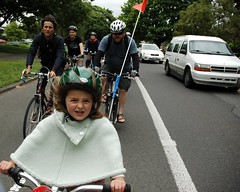
traffic on Willamette goes
40 mph (the limit is 35).
(Photos © J. Maus)
The Portland Bureau of Transportation (PBOT) is considering other options for how to improve bike access on N. Willamette Blvd after hearing loud and clear from adjacent homeowners that they don’t want to lose on-street parking.
The goal of PBOT’s North Willamette Boulevard Bikeway Development Project is to create a “low-stress” bicycling environment and improve bikeway access on this key link between North Rosa Parks Way and Woolsey (it’s one of five projects the City announced in May 2010). Since this project was first identified over a year ago, the idea was to create more space for bicycle traffic by re-allocating space currently being used for on-street parking.
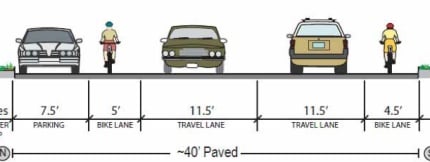
(Source: PBOT)
Analysis of the project zone by consultants showed that the 113 parking spaces have an extremely low utilization rate and nearly all the homes have either large driveways and/or sidestreets where parking is available. Their study concluded that “On‐street parking is more than adequate to accommodate existing demand,” and that,
“Given the low utilization of existing on‐street parking and availability of alternative parking opportunities on nearby cross streets, private driveways, and garages, there may be opportunities to prohibit on‐street parking in order to pursue innovative bicycle treatments on Willamette Boulevard.”
PBOT, in a presentation made during a neighborhood meeting on the project June 2nd, wrote, “On‐street parking seems the most likely candidate for trade‐off, given low use of on‐street parking.”
Below is a graphic showing results of a parking utilization analysis. Red signifies “high” usage, green shows low usage and the x’s are “no vehicles observed.”
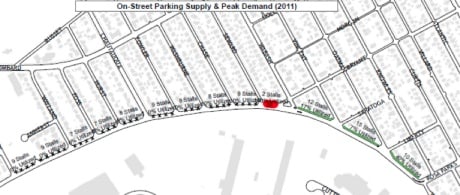
However, at that June 2nd meeting PBOT says they heard “key concerns” from homeowners about on-street parking and now they’ve decided to “explore other options” to find the needed space for the bikeway.
The road is currently 40-feet wide with a 7 1/2-foot parking lane, (substandard width) bike lanes in each direction, and two, 11 1/2 foot standard vehicle lanes.
In The Oregonian on Sunday, columnist Anna Griffin wrote a column with the headline, “Portland rightly backs off swapping Willamette Boulevard parking for bike lanes.” Here’s more from Griffin:
“City transportation engineers wanted to rip out almost a mile of parking along North Willamette Boulevard to make it safer for people on bikes. Neighbors objected, loudly and quickly. So the city backed off…
It’s a well-deserved short-term victory for neighbors… Their only real interest is in being left alone to enjoy magnificent views of the river and the port. Yet it’s also a troubling statement about where Portland’s 2030 Bike Plan is headed without better work from the folks at the top.”
After reading Griffin’s column, I asked PBOT for more about what happened at that meeting and where the project stands today. They responded with a bulleted list of “key concerns” from neighbors:
- Despite the low utilization, on-street parking is important for visitors, garbage trucks, mail carriers, service vehicles, yard sales, and other uses.
- Auto access to and from driveways is difficult, and the parking lane provides an important buffer for this movement.
- Speeds and volumes of motorized traffic on Willamette Blvd are too high [speed limit is 35 mph and about 50% exceed that according to PBOT], and this is a livability issue.
- Some people don’t like the behavior of some bicyclists.
Based on that feedback, PBOT tells me they “will explore other options that might better meet residents’ interests.”
It’s not clear what exactly those “other options” might be. Without the space currently taken up by the parking lane, there isn’t a lot of room to work with; there’s a steep bluff on one side and private lawns on the other.
Whether you chalk this up to a poor sales pitch by PBOT (as Griffin does) or just obstructionist neighbors resistant to any changes, the fact remains that something must be done. Unlike motor vehicle traffic, which has the state highway of N. Lombard just blocks away, Willamette Blvd is the only viable route for bike traffic — yet many people are afraid to ride on it because of the narrow bike lanes and fast cars.
We’ll keep you posted about what options PBOT comes up with.



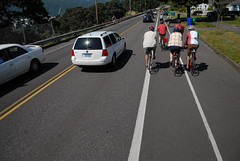
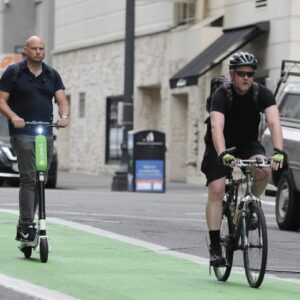
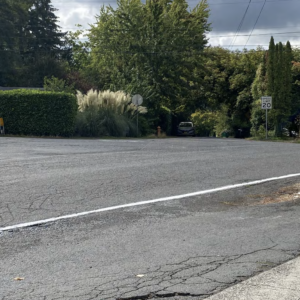
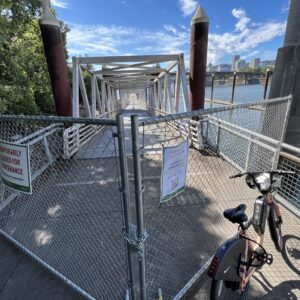

Thanks for reading.
BikePortland has served this community with independent community journalism since 2005. We rely on subscriptions from readers like you to survive. Your financial support is vital in keeping this valuable resource alive and well.
Please subscribe today to strengthen and expand our work.
Preservation of on street parking is the death of every ambitious bike infrastructure project in Portland.
Exactly. Progress in bicycle and alternative transit has peaked here in Portland if this is how things go now.
The same thing happened on Knott Street 20 years ago, and nothing has changed in that time at all.
i live on knott, and i would not want to see formal bike infrastructure here. the sporadic onstreet parking functions as traffic calming. nimby, thanks.
And I ride Knott every day. It doesn’t need any change. It’s fine as is.
… Between NE 21st and N Vancover that is.
What BURR said. Especially on streets like Knott, parts of 20th and Willamette that have underutilized parking.
I ride this route everyday, and this is the segment of Willamette the city is trying to spend money on?
In my opinion, this is the safest part of my commute. There is a Bike lane, the view is beautiful, and visibility is really good for seeing oncoming traffic and vehicles turning. If ‘fast vehcles’ on this route make people uncomforable riding N. Willamette, increase patrols, thus increasing revinew for the city.
If they want to improve safety on N. Willamette blvd, update the section between Fred Meyer and Saint John’s.
I agree. I keep seeing the city redoing streets that already have bike infrastructure on them while whole other segments of the city get ignored. I don’t get it.
Agree. We should be working on areas with no bike accommodations before we “upgrade” areas that are already reasonably good.
I disagree with you and Whyat. It’s not either/or… and IMO, we do need to upgrade existing bikeways that are inadequate for the context/volume of traffic they have. Wouldn’t you agree that similar safety risks exist when you have an inadequate bikeway that is used by hundreds of people a day as when you have no bikeway at all that sees just a few people a day?
Be careful here Jonathan. By this logic, if someone does a study that finds bikeways are under-utilized on a busy motorized vehicle street, they could then sacrafice bike infrastructure to the benefit of motorized traffic. (Just playing devil’s advocate)
I understand what you are saying, however, modifying this single mile stretch of N. Willamette with existing bike lanes, sidewalks and good visibility is not the place to advocate for better bike access right now. There are much higher priority areas in the city which would demonstrate a greater benefit to bicycle traffic. (especially since the study seems to indicate that the existing conditions are adequate for the current situation. Only speeding of vehicular traffic was noted as a danger)
I agree with them, I used to live on Washburne, so Willamette was my route to where I worked in deep SE. I had always found the cycling infrastructure on this street to be fantastic, the money is better spent elsewhere, perhaps on Rosa Parks.
As a former St. Johns resident/homeowner, I agree that it would be great to see a bike lane on Willamette between Alma and Richmond (e.g. between Fred Meyer and Safeway). I believe it’s indicated on the Bike Plan.
HOWEVER – this is a big however- the difference is that this particular segment, between Woolsey and Bryant, has NO alternative other than to go ride on Lombard. There are NO parallel neighborhood streets because the north-south blocks here have Lombard on one end and Willamette on the other. On the segments farther north/west from Woolsey, you can take alternative streets like Yale and Princeton (between Columbia Park and the railroad cut) and Jersey (between Fred Meyer and downtown St. Johns).
The availability of bike routes where parents don’t feel their children will be hit by cars going 40 mph, where the “interested but concerned” can be farther than 2 feet from passing cars, has a big role in increasing the use of bicycles. When people coming to and from 5 different neighborhoods to other parts of the city don’t have any choice but to ride on this or on Lombard, we have a problematic situation.
I also want to say that this segment, along with the part from UofP to Woolsey, is one of the windiest segments because it is on the exposed bluff. When you are heading downtown in the morning, the prevailing winds throughout winter are from the south and east. So you are not only riding into a headwind, but a crosswind is often buffeting you from the side and feeling like it’s going to blow you out of that substandard width bike lane and into the path of cars passing on your left. Not to mention the debris from the trees on the bluff that gets blown into that bike lane – leaves in fall, branches in winter. A lot of times I ended up taking the #44 bus in the winter because it was such a stressful experience.
the southbound bike lane is a bit narrow. i usually assert some portion of the travel lane, somewhat to the annoyance of overtaking motorists. once again, however, a case in which the presence of the lane striping creates a problem that would not otherwise exist. i could ride in exactly the same place, four or five feet out from the edge, and motorists would quietly overtake with no issues, but the stripe is telling them that i am too far to the left. my vc opinion.
On the plus side, the low parking utilization means that at any time you can just go ahead and declare that space to be a cycle track. We frequently go 3 abreast westbound.
Alright then, right side traffic lane gets sharrows, bike lane removed, bikes take the lane…with that volume, it would effectively turn the right side traffic lane into a bike lane anyways.
My family and I ride this street often to visit friends near Columbia Park at N. Woolsey. On our way home (going eastbound), especially at night, we ride on the sidewalk because the bike lane is so narrow and unsettling. Sidewalk riding has its own perils, but it’s the lesser of two evils when compared to trying to cross Willamette w/ 50% of the cars going 40 mph and then squeezing with a 5 and 8 year old into a 4.5 foot wide bike lane. I sure hope PBOT figures out something.
The eastbound lane also turns to the right enough that cars will crowd the lane, or encroach as they make the turn. That makes it much worse.
Actually if they shrunk the travel lanes to 10ft and moved both bike lanes into a protected two way cycletrack it seems like that might fit. But the residents are crazy if they think an occasional police crackdown is actually gonna make a difference with speeding. The road is designed for higher speeds so of course drivers use it at that speed.
Andrew has identified a good alternative. PBOT should consider this along with other creative solutions.
Cycle track here would be stupid.
A good way to ruin a fast cycling street though if that is what you are looking for.
Have you been smoking cycle crack?
I rode this route twice daily all last summer. Its absurd to desire “empty” on street parking spaces. It appears that the neighbors don’t want a cycle track. The on-street parking argument is a farce. There is more than adequate parking for everyone in that neighborhood. NIMBY’ism is alive and well on Willamette
I found some extra space!
– Reduce parking lane to 7ft
– Reduce vehicle lanes to 10ft
Gives us 3.5 ft, not much, but something!
Now, take both bike lanes, combine into a two-way cycletrack on the bluff side. Add 3 feet. No car doors, a potential 13ft wide bike facility + buffer. No parking removal. Everybody wins!
Here is a quick mock-up of what a consolidated, two-way separated bike lane (aka cycletrack) would look like. Physical barriers could be added later as utilization goes up.
http://www.flickr.com/photos/intersection911/5834142376
I think you have the right approach, but on the wrong side of the road! Take the cycletrack and put it on the north side next to the house-side curb. Shrink the parking to 7 feet and put it between the cycletrack and the travel lane, creating a parking-buffered cycletrack. So you have 11 foot two-way cycletrack, 7 foot parking, 11 foot travel lane, 11 foot travel lane = 40 feet. If the parking is so rarely used, it will wind up being an extra-wide for much of the time! Everybody wins and parking stays.
yeah, if someone is going off the edge i would rather it was the motorist
But I think the neighbors’ concern was that they would have trouble getting in and out of their driveways without the parking lane, and that they felt trash collectors, mail carriers, etc. needed the house-side of the street.
Besides, if you put the parking lane on the bluff side, we lose our awesome view to a wall of Chevy Tahoes. I vote bluff side for bikes.
Agreed! With a 10 foot car lanes, there is plenty of room for a cycletrack, buffered by (occasional) parking along the north side. And cars will go slower due to the narrower lane width.
PBOT should also take out the center line for cars. Having a yellow double line increases speeding, because it reduces uncertainty. A narrow 20 foot space, with parking delineated by paint on the north side and then a 4 foot buffer and a 9 foot cycletrack, would make for calmer traffic and a very safe bike facility.
You could also have the cycletrack on the south side, but then you need to build a physical curb to keep cars out of it, and westbound bikes would be looking right at the eastbound cars – not as comfortable.
That’s a great idea and one that takes the best advantage of safety and the view. Put in some speed bumps and diverters to keep the traffic speeds down. Put in something more than paint for separation from the motor vehicle traffic and it becomes a beautiful and safe route.
Amazing that a stretch with demonstrated low use can succumb to standard NIMBY mentality of homeowners. We all own that street, and it has an amazing view that should be accessible and enjoyable for cyclists, walkers and drivers alike.
I ride Willamette frequently and the main area that feels the most unsafe is the area in front of Univ. of Portland where the road narrows and the bike lanes disappear and the Eastbound Bluff side from the Univ. through to Rosa Parks. Almost everyone has a driveway along that stretch of road so I say make the homeowners use them.
Jonathan,
This proposal should go back to the drawing board. Removing residential curbside parking along Willamette is a really bad idea. I believe that a more creative design can maintain the curbside parking and provide a premium bicycle facility.
I’m wondering where people come up with the idea that taking away parking spaces equals lower home values? Does anyone have data on that? I know for my family, we’d pay more to buy a home on or near a bikeway…
Deborah – I wouldn’t be surprised if a study had been done but anecdotal evidence, even in Portland, favors homes with access to on-street parking. (When homeowners host relatives/friends for dinner, where will THEY all park?)
In car-centric America — and even in still-car-centric Portland — I’m sure you would be in the minority on this one.
We just asked our apartment complex to try to get some bike racks installed near our apartments, because when some of our friends come to visit, they have nowhere to park (except inside our apartment, where we are already storing our own two bikes). They were all for it, thankfully 🙂
Really, the residents’ desire to have empty parking spaces to hold yard sales is more important than bike facilities? I believe in working with communities to make changes, but there needs to be a broader consideration of community benefits beyond the concerns of the immediate neighbors. The streets are public right-of-way and belong to us all–and are funded by us all. Homeowners do not OWN the strip of asphalt in front of their house, and while their concerns should be heard and incorporated into the dialogue, other voices and needs should be heard as well.
These are the residents that don’t ride. I’m sure the residents that ride don’t mind.
so basically we wont be getting better bike lanes on both williamette and williams? come on portland, we can do better than that!
Yes. Great. Willamette and Williams are my main commuting routes from downtown to Saint John’s. Looks like I know which yard sales not to attend!
“key concerns” from neighbors:
…
“Speeds and volumes of motorized traffic on Willamette Blvd are too high [speed limit is 35 mph and about 50% exceed that according to PBOT], and this is a livability issue.”
I would hope that these neighbors recognize that every additional user who bikes instead of drives is one more person who most definitely is not speeding on this road?
“on-street parking is important for … yard sales…”
Are you kidding me?
I’m guessing these “neighbors” are the same people who like to complain about cyclists’ over-inflated sense of entitlement.
Jonathan, thanks for getting the clarification from PBOT on the neighbors’ key concerns – those all seem like pretty reasonable things to be concerned about (yes, even the last one). I live on a moderately busy street & I can sympathize with the homeowners’ safety concerns.
It’s true that in its current state Willamette Blvd leaves a lot to be desired as a bike corridor, especially going eastbound. And particularly going east from Woolsey – there are no good options there at all if you are biking with kids & want a little bit of a safety buffer.
“… Speeds and volumes of motorized traffic on Willamette Blvd are too high [speed limit is 35 mph and about 50% exceed that according to PBOT], and this is a livability issue. …” neighbors, according to PBOT
Then knock the speed limit down to 25 mph. It’s not as if St Johns is so far away from Portland that a 35 mph speed limit is really necessary to keep travel time reasonable.
Agreed. The biggest attraction for many drivers is that from N Richmond ( near the SJ bridge) to Rosa Parks, there is one light @ Portsmouth. Visually, Willamette is a ‘wide open’ street, which also encourages higher speeds. There is a crosswalk at the University of Portland with rapid flash lights, and the curves dampen speeds a bit, but not THAT much.
One of my biggest concerns is when the Waud Bluff trail is finally completed later this year, that there be a safe crossing at the trailhead, just east of the U of P, on Willamette. Wabash bike blvd crossing, as well as the Peninsula Crossing trail @ Carey creates other danger areas.
Perhaps the best approach to limiting car speed on Willamette would be creating ‘choke points’ where trails and bike blvds cross Willamette that forces cars to slow, so unimpeded speed does not add to the challenges of keeping Willamette safe for all levels of riders.
Incidently, I usually ride Amherst, between Carey ( next to the railroad ‘cut’) to Woolsey,because its a much quieter, more relaxing ride. However, once you get east of Woolsey, you are pretty much committed to Willamette, as the blocks between Lombard and Willamette are monolithic ‘super blocks’ with no streets between.
In short, slow the car traffic on Willamette, and on street parking would present little challenge. I don’t believe most residents along Willamette would object to a calmer boulevard.
Bringing down the speed down could be a first step. See how that goes, first, before resorting to more involved measures.
As other people have remarked, Willamette Blvd is one of Portland’s most scenic close in routes. Many changes take adjusting to, but once road users of the motor vehicle variety were given a legitimate excuse to slow down, they’d very likely enjoy the drive more.
If a chance exists that the boulevard can be improved sufficiently at least for awhile, without removing street parking, it’s probably worth giving it a try. No point inconveniencing people living in houses along the street if there’s a simpler way to get a handle on motor vehicle traffic and avoid removing on-street parking.
Unfortunately, that has to go through the unfortunate process of involving ODOT in the process, which means it will probably never get done.
Anna Griffin wrote: “Their only real interest is in being left alone to enjoy magnificent views of the river and the port.”
Not true. Their real interest seems to be having the city maintain for them a strip of parking lot in front of their house, on which they can park an SUV with the words “BLOW ME” prominently written all over it.
If you don’t know what I’m talking about, just drive or ride up there once, and you’ll see it. This is what our tax dollars are paying for: subsidizing the storage of private vehicles with obscenities on them.
Is there a Google streetview of this?
I couldn’t find it in Street View. Actually, there aren’t many cars parked on the road at all. Which kind of goes to prove the point- this should be a travel lane, not a parking lane.
Ha! I know which one you mean
Ha! That thing! I think you pronounce it, “Blaume”, from the way it’s written on the truck.
yeah, that is incredibly tacky and not at all a magnificent view.
The “blow me’ SUV is small potatos compared to the glass van with the rack that protrudes out into the bike lane. He often parks it in the driveway, but not always. Words could never hurt like whanging into that rack on a dark night.
I’ve got this funny notion that roads are not just a local asset but a regional asset. We ALL also PAY FOR the construction and maintenance of roads in a region.
As such the use of travel grade (road) real estate for storage of private property is disproportionately a very local use and detracts from the ability of ALL non-local users.
Just because a road passes by your hous or bussines does not mean you own it: get over yourselves.
Shouldn’t take away the privalege of on street parking. I’m not a biker, but do beleive it should be safe for commuters in cars, as well as the cyclists. I would appriciate the idea of one, “large” bike lane for east and westbound commuting. This should be looked at city wide. My main concern is the folks traveling down a street like, say SE Stark that have absolutely no room for a car and a bike. Does a car need to slow waay down and inhibit traffic, does it cross the line and potentially hit oncomming traffic? Its a matter of saftey. Perhaps designated biking roads would work better.
i gather you want to designate stark as nonbiking
I love this quote: “Some people don’t like the behavior of some bicyclists.”
Does that mean if “some people” don’t like the behavior of “some motorists”, the PBOT will take out motor vehicle lanes? If it does, I’m sure we could start a petition…
I don’t understand why the city is listening to these residents and considering their opinions. Change needs to happen. You can’t want things to be better and then fight against it because of your own greedy self-interests. Why does the city cater to them? There are plenty of other residents that would love to live there.
Indeed – where IN the DEED to the property does it say the homeowner is entitled to auto, hovercraft, camper or SUV parking in perpetuity- NOT even on the property. Seems absurd. I say, put it to the homeowners one by one, keep “your” on-street parking, and pay $400 a year infrastructure tax. Give it up, go scott free. And, whenever the property changes hands, the on-street parking is “condemned” by right of eminent domain by the city, though it shouldn’t even have to come to that.
Roads are great feats of Roman engineering, days of work and tonnes of stone and fuel for workers and machinery.
Money: roads cost a LOT of money to build and maintain and yet we still build extra road surface that will never need to be used to within 5% of its design parameters. A vehicle at rest upon a surface cause much less wear than vehicles in motion over the same surface.
In essence we are paying taxes to put chrome, tail fins and neon lights on a piece of public property that needs to be stronger than bare dirt. And pay we do.
Place an imaginary number upon the price for every square foot of paved road surface: call it “X”.
How many miles of on street parking do we have in Portland? Lets call the total square footage of paved road surface used for on street parking (and thus not useable by the rest of the public) “A”
A / X = % extra paid for a road with on street parking.
For example: N Williams at Beech Street is 40′ wide comprised of: 2 – 10.5′ auto travel lanes, 2 – 7′ parking lanes and 1 – 5′ bike lane.
14′ / 40′ = 35% markup in the cost of building this segment of N Williams.
So in a time of fiscal contraction we have to ask ourselves: do we stop spending public money on projects that aren’t useable by the general public or do we find a way to tax public parking land for private gain at the expense of taxpayers?
I ride this road every day and it is the best part of my ride. Its completely safe and I’ve never thought of the lanes as too small except on the bends where cars cut the corners. Cars driving 5 mph over the limit? Thats standard everywhere and its nothing to get hysterical about. Homeowners being reluctant to change? Ditto. On street parking is viewed as an amenity and this should not be difficult to understand. If the city is going to propose change to a long-standing situation then the burden of proof is on them. Why not prioritize the real problem locations eg the on/off ramps on Greeley that giant trucks zoom up? For some reason those stick out in my mind as a problem, not the perceived skimpy lanes on a generally placid street.
Knowing that Anna Griffin and Joe Rose continue to get paid to write this stuff makes me a little ill. “Rightly”? Seriously?
Seriously. The Oregonian really needs to be bought back from their awful chain and needs actual local columnists that know the area.
Yeah that “blow me” suv has always irked me.
This is another dumb idea that the city has come up with to fix a problem that does not exist. I don’t regularly ride Willamette, but I usually try to work it into a ride if I’m coming or going into the west hills.
And don’t most cyclists own cars, I wander where they get parked?
when i used to own a car it was usually parked on the impound lot
“Private lawns on the other” side? Exactly where is the property line? Is there room within the easement for a separated bike facility?
Or, make it pay-to-park.
I ride from the entire stretch of Willamette most every day and at all times of the day. I agree with the residents that the parking should remain. It isn’t used much during the day, likely when PBOT did their analysis, but they are used more heavily at night.
That said, people drive WAY too fast on this road given the number of joggers, walkers, kids, and bikes. My suggestion would be to put diverters at Ida and Portsmouth to make Willamette a non-through street and put traffic on Lombard (being re-paved now, YAY!) where it belongs. This street is a beautiful neighborhood street and with diverters and speedbumps it would become far less trafficked, likely local only, and cars would be less able to treat it like a formula-1 course.
Also, North Portland Greenway!
And I make these suggestions as someone who lives just off Willamette, so making it a non-through street would be a total PITA for me, but worth it.
Notice Willamette EAST of Rosa Parks. Low speed, low volume, very nice for everybody, including the homeowners. I think you are on to something with the diverter idea. Except some drivers would backtrack through the neighborhood to get back onto Willamette. Its that much more attractive than Lombard.
I’ll support on street parking IF:
(1) my tax dollars no longer go to maintaint surfaces or pave any new areas designated for on street parking
(2) all real estate currently in use for on street parking will be sold to adjacent landowners at market value and taxed at the full rate for the original plot.
[a] if the adjacent landowner is commercial the newly aquired property should be zoned and taxed as commercial parking lot and should be subject to all ordinaces as such.
(3) a permanent easement on the sold public land, previously used as on street parking, will mandate that the real estate will in perpetuity be available to the general public for use as parking. The landowner’s only recorse wil be to sell the land back to the government; the government then has the option of changing the zoning.
I emailed the project manager:
ellen.vanderslice@portlandoregon.gov
Do what you can for a better future!
i go there once in while on weekend. there are a few tight spots but overall not bad. just focus on tight spots. more enforcement (photo radars will do). police cant be everywhere.
I rode this stretch yesterday at 530pm, and it was busy. I counted ONE, yes ONE vehicle parked on the street in that stretch.
I live just off Willamette and regularly ride this section. Like many others, I don’t feel this route is particularly dangerous, nor is changing the posted speed limit going to make any difference to speed. (Speed is determined not by posted limits, but by street design.) I think the cycleway is an interesting option, but I wouldn’t consider this an especially high priority.
Like Deeeebo above, I consider Greeley to be of far, far higher concern. That road is *dangerous* and there aren’t a lot of alternatives when heading into downtown from points west of Greeley that don’t involve major detours (Interstate or Vancouver/Williams, or if you live in St Johns, Hwy 30, which is just as scary as Greeley).
As someone who has biked Greeley even long before it was striped for bike lanes, I agree there aren’t a lot of alternatives. There is a high amount of trucks and cars generally drive 55+. But still, I wouldn’t classify Greeley as dangerous. Less than ideal? Yes. Lombard/HW 30? Yes, I’ve biked that too, and to me that feels more dangerous.
The parking strip between the curb and sidewalk is really wide along most of project area and residents don’t have trees planted so as not to ruin the view, why not just carve out a few parking places or pockets here. Sidewalk users would still have the ‘low usage’ parking and bike lane as a buffer from traffic.
On a citywide basis, there should be a policy that states providing for safe transportation needs should trump parking. Not just on Willamette.
Free on street parking is no guarantee.
Just because you buy a house on Willamette doesn’t entitle you to parking on said street.
And, just because people start a business on a street like Williams doesn’t entitle them to have on street parking. Buy a parking lot if you want to ensure parking.
Don’t stop projects that will improve your neighborhood because of it.
Some of these people need to wake up and smell the cat food.
Unfortunately, it should be either/or at this point in time because there are several key pieces of infrastructure missing, which trumps existing infrastructure improvements, IMO.
As an example; while the newly minted Springwater trail is nice, it hurts my heart that $8mil was spent doing it, while there are so many competing infrastructure deficiencies that could have benefited from that $. If you pay your rent before you spend money on a vacation, you may appreciate the idea of laying ALL the infrastructure first, then going back to tweak things that need tweaking.
I think your sentiment is appropriate, Jonathan but should be tempered with practical needs in light of limited means.
I strongly disagree. At this point high quality infrastructure is a better use of $$ than not great improvements. The rate we’re building bike boulevards is good but we really need things like the Springwater, NorthPortland Greenway, and a sullivan’s gulch trail if we want to push cycling numbers higher.
I agree.
Wouldn’t $8million be better spent on a new route such as the Sullivan’s Gulch development instead of the repaving of Springwater?
After we have infrastructure, let’s go back and pretty up the rough edges.
Once again, not every street is — or will be, or should — appropriate for bicycling. Trying to make as many streets as possible suitable for bicycling is like tilting at windmills and will only aggravate all the concerned parties more.
The more I read about this stuff, the more I’m inclined to agree with folks like Grant Petersen, who say that it’s too late for American cities; that they will NEVER become even remotely like Amsterdam. Subsidies, demographics and mobility of population all contribute to this complicated picture; simply moving car parking out of the way by force and adding cycle tracks won’t solve the large pieces of this puzzle, nor can it undo a century of car-centric planning and construction of our cities.
I think it’s time to consider creating streets that are clearly designated:
a. bike/ped ONLY
b. motor vehicle ONLY
c. “sharrow” indicated (residential streets) and suitable for sharing by bikes, peds and low-speed motor vehicles. In this last one, actually enforcing lower speed limits will go a long way towards making it happen.
Finally, it’s time to stop dreaming and leave the busiest multi-lane thoroughfares — especially those near freeway ramps — alone. We are long past the point of being able to rebuld these streets according to a more sustainable vision; and we will simply have to wait for Peak Oil and other socio-economic factors to run their course. In a post-Critical Mass world, bicycle riders will have to accept some more compromise.
The problem is that Willamette Blvd is not a busy multi-lane thoroughfare. There are plenty of streets that should take a greater motor traffic load available nearby. The residents of this street certainly would not want more traffic — they say cars already travel too fast on the street as it is. They just don’t want to give up an entitlement to solve a problem they’ve identified.
As for segregating all roads into car only, bike only, and sharrow, it’s a great idea, but how could you practically eliminate all cars from any street that people live or do business on? If a policy like that were enacted, my guess is the car-only streets would get designated first, then the sharrow streets, then they’d forget about the last kind. It’s a bad compromise.
The main problem with N Willamette Blvd is that there are no stop signs or signals from N Greeley & N Rosa Parks to N Willamette & N Portsmouth. This allows motor vehicles to speed up and spread out making cyclist nervous has they ride and home owners nervous has they try to get in and out of their driveways. A stop sign or signal would slow vehicles down and bunch them up.
The speed and spread of motor vehicles was the main safety concern at N Wabash and N Willamette also, but instead of a stop, PBOT installed a center island refuge so folks only have to risk their lives one lane at a time instead of two.
Never is a long time. Can’t you imagine some wagon maker 100 years ago saying that city streets would never accommodate more than a handful of automobiles? After all, they’re dangerous, they smell bad, and they’re ridiculously inefficient (and expensive to operate) compared to a horse.
What do you think would happen if our gas prices rose to match prices in Europe?
I think we’d see a lot of angry people.
I’m not sure how that anger would be manifest; I suppose that would depend on how quickly the prices went up. A gradual price increase (like what we’ve seen in 2008 and again this winter/spring) might inspire more folks to consider other transportation options. A sudden and steep increase — perhaps the result of ending subsidies or a drastic change in the global oil supply — might provoke a much angrier response.
Most large-scale socio-economic change does not come about voluntarily. If it did, we’d be a lot farther along by now, on so many fronts.
When I’ve have ridden Willamette I’ve found it perfectly usable, but far from perfect. I agree that the biggest problem on Willamette is excessive vehicle speeds. Not just the number of vehicles traveling 5mph over the speed limit … it’s also the smaller but significant number traveling 10, 15, 20mph over the speed limit.
I would fully support some sort of traffic calming on Willamette. The most likely problem is that this is likely fire truck route, which severely restricts what can be done. Speed tables are probably not going to pass muster, nor would diverters. Could we get away with adding a few stop signs, as JE has suggested?
Or … how about this: instead of stop signs, how about 4-way (or, on most of Willamette, 3-way) flashing red lights? AND, just as many municipalities have signals that can be activated by emergency vehicles, we could design a signal that flashes red most of the time, but can switch to green for an approaching emergency vehicle (and of course solid red for conflicting movements). This sort of signal would enable us to implement traffic calming on a lot of minor arterials (not just Willamette) where we currently can’t due to emergency services concerns.
Such a traffic control device is probably not supported by the current MUTCD, but variances can be granted for experimental use, as has previously been done for HAWK signals in Portland and Flashing Yellow Arrows in Beaverton — now incorporated in MUTCD after successful local pilot projects.
“Some people don’t like the behavior of some bicyclists.”
Some people don’t like the behavior of some car drivers or snotty NIMBY neighbors. What does this have to do with anything? Did PBOT actually list this as a reason for delaying this project?
The other thing to consider is we could keep select parking spots on every block so there is some flexibility, and meanwhile it would create a meandering bikeway that would add some horizontal deflection for motorists. I think we can take the neighborhood concerns + safety concerns and make some lemonade here!
The great irony in all this, is the same one that characterizes the whole cars-first transportation system: Cars are bad, except mine. The neighbors don’t like the “speeds and volumes of motorized traffic,” but also want a place to park their own vehicle (or the vehicles of those who serve them). Both of which, I guess, magically don’t contribute to the traffic volume. Classic forest vs. trees blind-spot that keeps people doing the same silly thing over and over, ruining their own nests, gradually impoverishing themselves, and enriching our rentier class.
The traffic volume on this street is not due to local users. It’s most people using Willamette as a cut through/alternate route to Lombard. Owning a car doesn’t preclude you from trying to manage traffic.
If you can’t live without parking spaces you don’t use, perhaps it’s time to carry out seppuku because you fail at life…
Itttttt’s BAAACK!